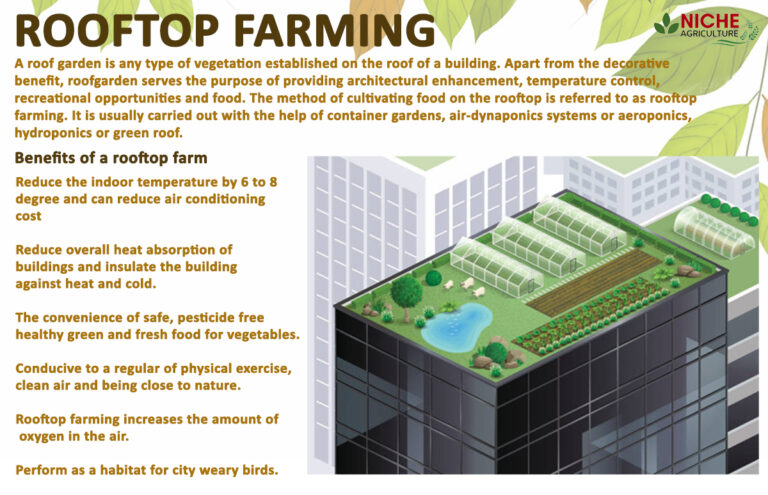
“Rooftop farming- A Viable measure in the development of Agriculture”
What is Rooftop farming?
Rooftop Cultivation is the development of fresh produce on the top of buildings inside the CBD of major cities. The foremost effective form is hydroponics strategies using a specially planned Greenhouse.
Introduction
Urbanization has become a common phenomenon within Indian society. Within the repercussion of ever-growing urbanization sprawl, we are losing our rural land each hour and the populace is growing by leaps and bounds at the same time. It implies we’ll have less land to grow food on and more mouths to feed which is alarming and poses a greater challenge for our future eras. Rooftop farming is a viable option to handle this situation in the coming future.
The need to recuperate green spaces is getting to be progressively critical to preserving natural quality, as the impenetrable spaces are replacing them quickly. Introducing housetop ranches or green rooftops in private and commercial buildings is one of the options that can decrease the negative impact of advancement because it has various natural, financial, and social benefits.
Green Roof Systems
Green roof systems hold 60-100% of the stormwater they get. In addition, green rooftops have a longer life-span than customary rooftops. They are protected from ultraviolet radiation and extraordinary flux in the temperature that causes roof membranes to fall apart and results in spillage amid the rainy season. Vegetation keeps up the coolness of the roof amid the summer as the plants act as an insulation layer and they shade the roof from the scorching heat.
All commercial and private buildings with roof gardens are required to undergo roof checks at least twice a year. All rooftops, indeed in our pre-grown framework ought to be weeded occasionally. Green roof plants ought to be looked over for parasitic illnesses and creepy crawly issues on a regular basis. To grow vegetables, the installed system ought to guarantee that there’s sufficient space between plants and an adequate layer of soil for the vegetation of the plants.
Types of Rooftop Gardens
- Extensive Rooftop Garden
This type of roof garden requires the least layer of soil substrate and subsequently it is simple to preserve. These gardens are appropriate for storage facilities, garages, rooftops, or other extra buildings around the house. At the same time, it has less aesthetical value as the types of vegetation that grow on this is exceptionally constrained. Lichen and greenery are the best-suited vegetation for this sort of garden. Lichen can effortlessly develop on surfaces like plastic, metal, and glass. Moss, on the other hand, could be a small plant that requires less nourishment for its survival and high soil stickiness for its development. This roof garden is less costly in terms of vegetation types and development and ideal for a muggy climate.
- Semi-Intensive Roof Gardens
This sort of roof garden requires a deeper soil layer that increments the diversity of plant species. More steady construction is required for this type due to vegetation, the greater burden to the soil, and water retainment. Vegetation can be done with lower species of the Sedum class. As these species are juicy, they don’t require frequent watering. However, vegetation requires extra watering amid drawn-out dry periods. Wildflowers that don’t require maintenance can be developed effortlessly in such roof gardens.
- Intensive Roof Gardens
Vegetation comparative to that of a backyard cultivate like blooms, bushes, trees, and several park components can be planted in this sort of gardens. However, this roof garden requires huge, steady developments and subsequently, most of the buildings are not appropriate for intensive roof gardens. Other than fundamental maintenance needs, it moreover demands extraordinary consideration amid the water system.
Advantages of Rooftop Farming
- It converts CO2 emissions
- It produces oxygen
- It diminishes the warm of buildings and vitality costs
- It makes an environment for wildlife
- It decreases the surrounding temperature
- It captures and harvests rainwater
- It decreases stormwater runoff and discharge
- It makes expansive catchment ranges.
Disadvantages of Rooftop Farming
- Greater expense than traditional roofs
Unfortunately for green rooftops, they do tend to be marginally more costly than the conventional alternative. One of the significant reasons for this being the additional bolster required to handle the increased load.
- Increase in Weight Load
There’s no question about it, green rooftops are heavier and as such, require more basic support to be executed. Ordinarily, the expansion of a green roof will include between 50 and 200kg/metre squared to an existing housetop. In spite of the fact that a few housetops will have to be retrofitted to manage the increase in the stack, luckily flat rooftops are often able to handle this capacity.
- Requires Extra Maintenance
You ought to treat your green roof as a garden and as such, it’ll require watering, bolstering, and weeding. You’ll undertake this yourself or indeed employ somebody to take care of the space. Either way, it’s awesome to keep on top of this brilliant green zone.
Conclusion
Rooftop farming can be a viable alternative for urban agribusiness on account of diminishing agrarian arrive, particularly in Indian cities. It can play a significant part in urban environmental management and enhance the persistently deteriorating quality of air while offering natural and fertilizer-free produce.
